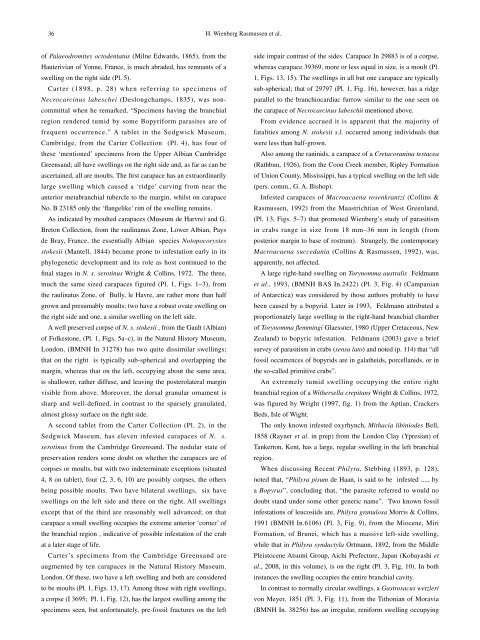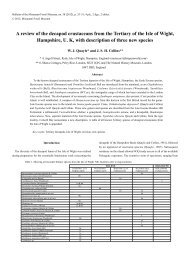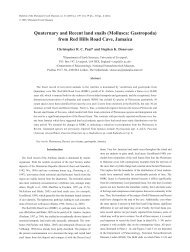Raninidae infested by parasitic Isopoda (Epicaridea)
Raninidae infested by parasitic Isopoda (Epicaridea)
Raninidae infested by parasitic Isopoda (Epicaridea)
You also want an ePaper? Increase the reach of your titles
YUMPU automatically turns print PDFs into web optimized ePapers that Google loves.
36<br />
of Palaeodromites octodentatus (Milne Edwards, 1865), from the<br />
Hauterivian of Yonne, France, is much abraded, has remnants of a<br />
swelling on the right side (Pl. 5).<br />
Carter (1898, p. 28) when referring to specimens of<br />
Necrocarcinus labeschei (Deslongchamps, 1835), was non-<br />
committal when he remarked, “Specimens having the branchial<br />
region rendered tumid <strong>by</strong> some Bopyriform parasites are of<br />
frequent occurrence.” A tablet in the Sedgwick Museum,<br />
Cambridge, from the Carter Collection (Pl. 4), has four of<br />
these ‘mentioned’ specimens from the Upper Albian Cambridge<br />
Greensand; all have swellings on the right side and, as far as can be<br />
ascertained, all are moults. The first carapace has an extraordinarily<br />
large swelling which caused a ‘ridge’ curving from near the<br />
anterior metabranchial tubercle to the margin, whilst on carapace<br />
No. B 23185 only the ‘flangelike’ rim of the swelling remains.<br />
As indicated <strong>by</strong> moulted carapaces (Museum de Harvre) and G.<br />
Breton Collection, from the raulinanus Zone, Lower Albian, Pays<br />
de Bray, France, the essentially Albian species Notopocorystes<br />
stokesii (Mantell, 1844) became prone to infestation early in its<br />
phylogenetic development and its role as host continued to the<br />
final stages in N. s. serotinus Wright & Collins, 1972. The three,<br />
much the same sized carapaces figured (Pl. 1, Figs. 1–3), from<br />
the raulinatus Zone, of Bully, le Havre, are rather more than half<br />
grown and presumably moults; two have a robust ovate swelling on<br />
the right side and one, a similar swelling on the left side.<br />
A well preserved corpse of N. s. stokesii , from the Gault (Albian)<br />
of Folkestone, (Pl. 1, Figs. 5a–c), in the Natural History Museum,<br />
London, (BMNH In 31278) has two quite dissimilar swellings;<br />
that on the right is typically sub-spherical and overlapping the<br />
margin, whereas that on the left, occupying about the same area,<br />
is shallower, rather diffuse, and leaving the posterolateral margin<br />
visible from above. Moreover, the dorsal granular ornament is<br />
sharp and well-defined, in contrast to the sparsely granulated,<br />
almost glossy surface on the right side.<br />
A second tablet from the Carter Collection (Pl. 2), in the<br />
Sedgwick Museum, has eleven <strong>infested</strong> carapaces of N. s.<br />
serotinus from the Cambridge Greensand. The nodular state of<br />
preservation renders some doubt on whether the carapaces are of<br />
corpses or moults, but with two indeterminate exceptions (situated<br />
4, 8 on tablet), four (2, 3, 6, 10) are possibly corpses, the others<br />
being possible moults. Two have bilateral swellings, six have<br />
swellings on the left side and three on the right. All swellings<br />
except that of the third are reasonably well advanced; on that<br />
carapace a small swelling occupies the extreme anterior ‘corner’ of<br />
the branchial region , indicative of possible infestation of the crab<br />
at a later stage of life.<br />
Carter’s specimens from the Cambridge Greensand are<br />
augmented <strong>by</strong> ten carapaces in the Natural History Museum.<br />
London. Of these, two have a left swelling and both are considered<br />
to be moults (Pl. 1, Figs. 13, 17). Among those with right swellings,<br />
a corpse (I 3695; Pl. 1, Fig. 12), has the largest swelling among the<br />
specimens seen, but unfortunately, pre-fossil fractures on the left<br />
H. Wienberg Rasmussen et al.<br />
side impair contrast of the sides. Carapace In 29883 is of a corpse,<br />
whereas carapace 39369, more or less equal in size, is a moult (Pl.<br />
1, Figs. 13, 15). The swellings in all but one carapace are typically<br />
sub-spherical; that of 29797 (Pl. 1, Fig. 16), however, has a ridge<br />
parallel to the branchiocardiac furrow similar to the one seen on<br />
the carapace of Necrocarcinus labeschii mentioned above.<br />
From evidence accrued it is apparent that the majority of<br />
fatalities among N. stokesii s.l. occurred among individuals that<br />
were less than half-grown.<br />
Also among the raninids, a carapace of a Cretacoranina testacea<br />
(Rathbun, 1926), from the Coon Creek member, Ripley Formation<br />
of Union County, Mississippi, has a typical swelling on the left side<br />
(pers. comm., G. A. Bishop).<br />
Infested carapaces of Macroacaena rosenkrantzi (Collins &<br />
Rasmussen, 1992) from the Maastrichtian of West Greenland,<br />
(Pl. 13, Figs. 5–7) that promoted Wienberg’s study of parasitism<br />
in crabs range in size from 18 mm–36 mm in length (from<br />
posterior margin to base of rostrum). Strangely, the contemporary<br />
Macroacaena succedania (Collins & Rasmussen, 1992), was,<br />
apparently, not affected.<br />
A large right-hand swelling on Torynomma australis Feldmann<br />
et al., 1993, (BMNH BAS In.2422) (Pl. 3, Fig. 4) (Campanian<br />
of Antarctica) was considered <strong>by</strong> those authors probably to have<br />
been caused <strong>by</strong> a bopyrid. Later in 1993, Feldmann attributed a<br />
proportionately large swelling in the right-hand branchial chamber<br />
of Torynomma flemmingi Glaessner, 1980 (Upper Cretaceous, New<br />
Zealand) to bopyric infestation. Feldmann (2003) gave a brief<br />
survey of parasitism in crabs (sensu lato) and noted (p. 114) that “all<br />
fossil occurrences of bopyrids are in galatheids, porcellanids, or in<br />
the so-called primitive crabs”.<br />
An extremely tumid swelling occupying the entire right<br />
branchial region of a Withersella crepitans Wright & Collins, 1972,<br />
was figured <strong>by</strong> Wright (1997, fig. 1) from the Aptian, Crackers<br />
Beds, Isle of Wight.<br />
The only known <strong>infested</strong> oxyrhynch, Mithacia libiniodes Bell,<br />
1858 (Rayner et al. in prep) from the London Clay (Ypresian) of<br />
Tankerton, Kent, has a large, regular swelling in the left branchial<br />
region.<br />
When discussing Recent Philyra, Stebbing (1893, p. 128),<br />
noted that, “Philyra pisum de Haan, is said to be <strong>infested</strong> ..... <strong>by</strong><br />
a Bopyrus”, concluding that, “the parasite referred to would no<br />
doubt stand under some other generic name”. Two known fossil<br />
infestations of leucosiids are, Philyra granulosa Morris & Collins,<br />
1991 (BMNH In.6106) (Pl. 3, Fig. 9), from the Miocene, Miri<br />
Formation, of Brunei, which has a massive left-side swelling,<br />
while that in Philyra syndactyla Ortmann, 1892, from the Middle<br />
Pleistocene Atsumi Group, Aichi Prefecture, Japan (Kobayashi et<br />
al., 2008, in this volume), is on the right (Pl. 3, Fig, 10). In both<br />
instances the swelling occupies the entire branchial cavity.<br />
In contrast to normally circular swellings, a Gastrosacus wetzleri<br />
von Meyer, 1851 (Pl. 3, Fig. 11), from the Tithonian of Moravia<br />
(BMNH In. 38256) has an irregular, reniform swelling occupying





